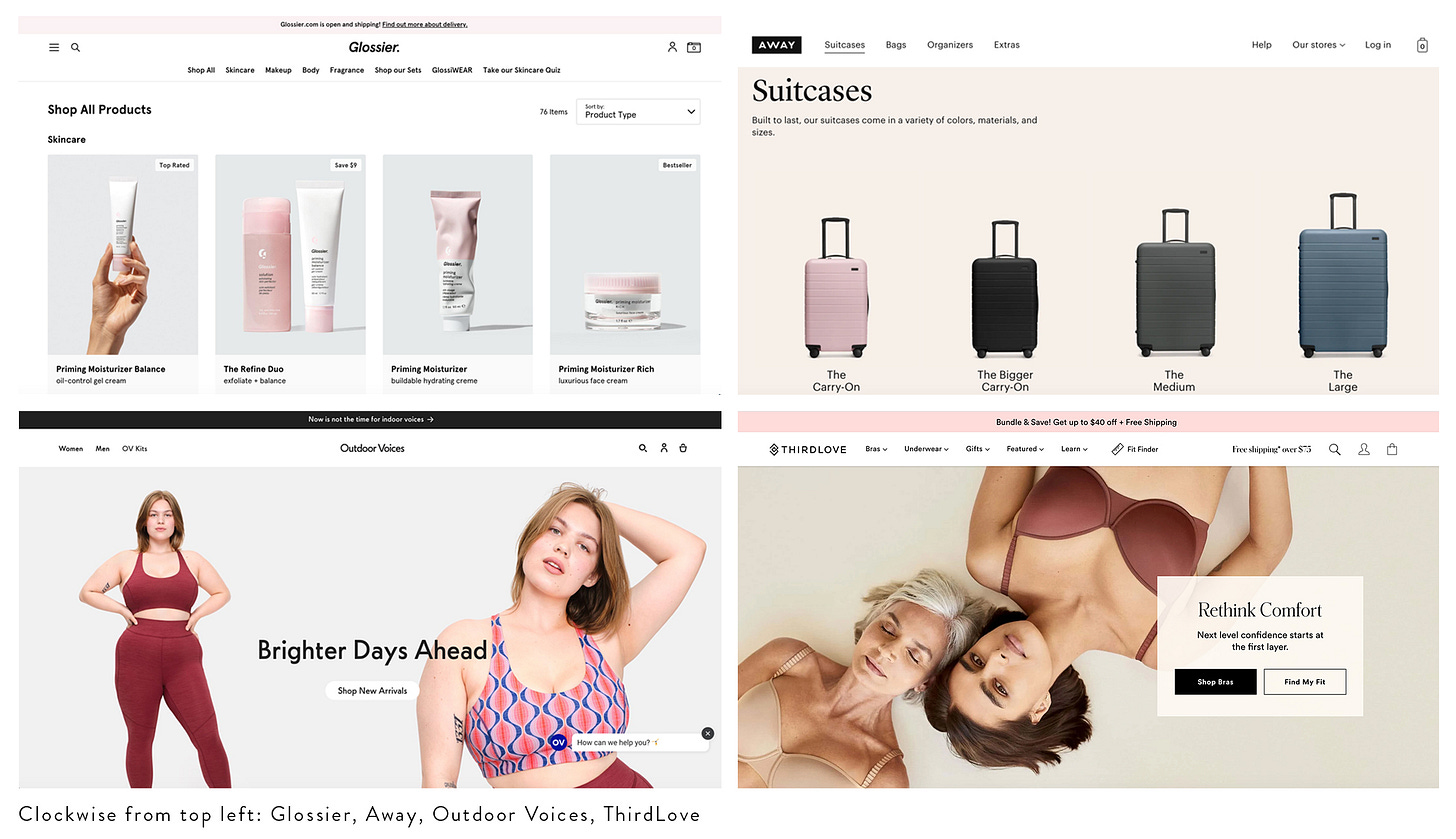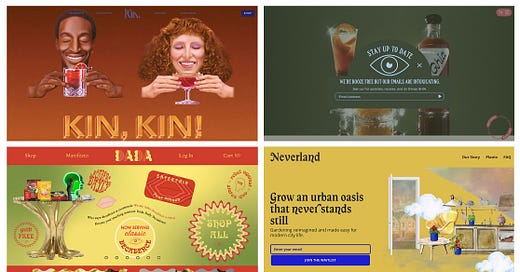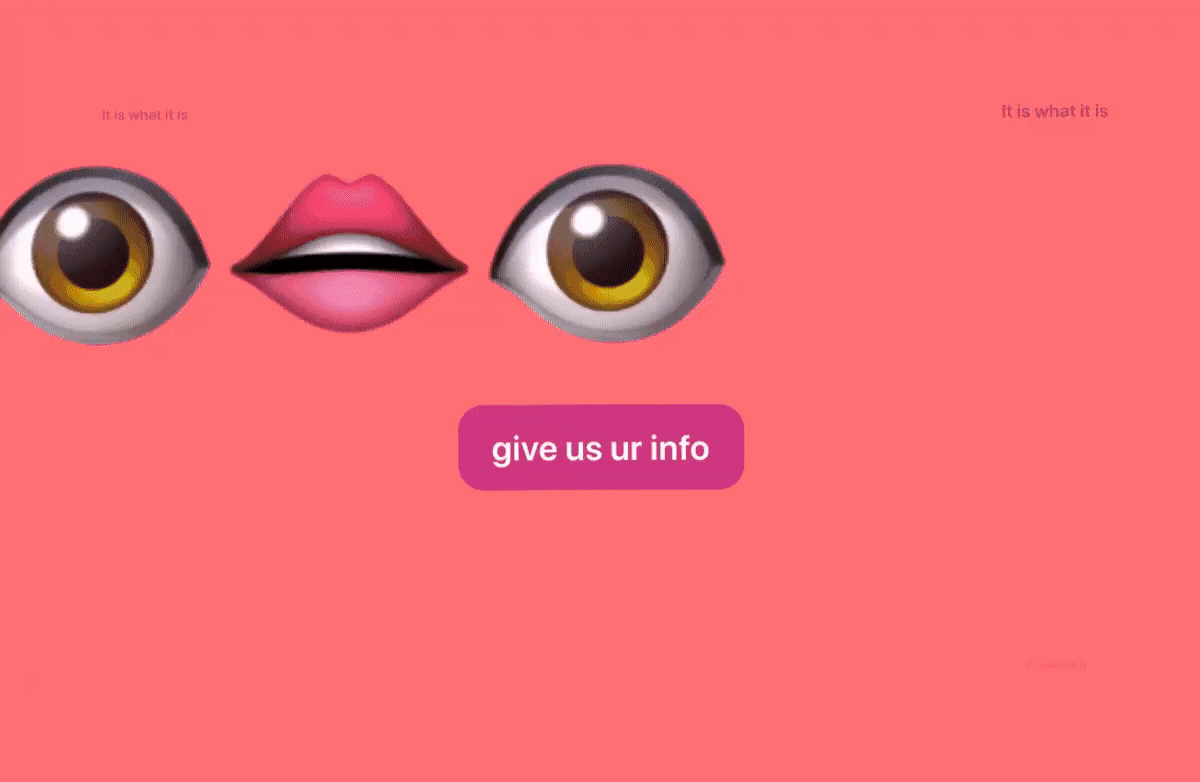
A newsletter about branding, startups, and mission-driven companies aiming to make the world a better place.
👋 Welcome to issue #4 of For The Love, so happy to have you all here! Today we’ll be discussing:
A new trend in Direct-to-Consumer branding
A roundup of things that launched this week, including your favorite Italian cocktail...in a box
An AI temperature screening ad gone wrong
If this newsletter was forwarded to you and you don’t want to miss an issue you can sign up here.
⚡ For The Love of Branding
You know the look—the soothing, powdery shades, the softly rounded shapes, the sans serif fonts.
The Millennial aesthetic is everywhere.

Easy and approachable, “the millennial aesthetic aims its appeal at everyone,” as Molly Fisher writes in her biting essay for The Cut.
“Propagated by brands and advertisements, it is a fundamentally commercial aesthetic...If you simultaneously can’t afford any frills and can’t afford any failure, you end up with millennial design: crowd-pleasing, risk-averse, calling just enough attention to itself to make it clear that you tried.”
It’s all very polished, very palatable, and very tasteful.
And now for something completely different...

From garish colors to disembodied appendages—a new guard of brands is throwing “palatable” out the window.
Melanie Masarin, founder of Ghia, a non-alcoholic aperitif brand, explained,
“All conversations are happening digitally now so I wanted to create something that’s so offline… beyond marketing branding and into human branding.”
She commented on the floating eye (a Surrealist favorite) that greets you on her website, calling it “an eye of clarity.“
I asked Claire Olshan, founder of Dada Daily, why she took this risk with her branding.
“I didn't want to pigeonhole myself into this whitewashed world that doesn't exist. I was born in New York - there is no such thing as a serene moment…” “This washed out color palette is not a real version of where we live. And how we live. “
Even brands that are sticking with the pastel palette and sans serif fonts are pumping up the saturation, adding textures and gradients, and embracing whimsical details.

It’s as if Salvador Dali took a seed round from Forerunner Ventures.
This new aesthetic is characterized by disjointed, jarring imagery, including floating clouds and disembodied appendages. I wouldn’t be surprised to spot a melting clock in the near future.
Flat blocks of color have given way to textures and gradients. We find highly stylized calligraphic serif fonts and detailed illustrations. Unexpected, high-contrast color combinations are splashed right over the soothing tonal pastels of your favorite subscription luxury linens website.
It brings to mind the term “New Spirit.”
In 1917, French poet and playwright Guillaume Apollinaire became the first person to coin the term “Surrealism” when he reviewed the ballet Parade:
This new alliance—I say new, because until now scenery and costumes were linked only by factitious bonds—has given rise, in Parade, to a kind of surrealism, which I consider to be the point of departure for a whole series of manifestations of the New Spirit that is making itself felt today and that will certainly appeal to our best minds. We may expect it to bring about profound changes in our arts and manners through universal joyfulness, for it is only natural, after all, that they keep pace with scientific and industrial progress.
We may not be feeling universally joyful at the moment, but there are a lot of contextual similarities between today’s anxiety economy and the era of the Surrealist art movement’s birth.
Time for a quick art lesson.
Born during the onset of the Spanish Flu, and the aftermath of WWI, Surrealism was a counterculture movement known for its cerebral, clever, idiosyncratic imagery. It continued through one of the most tumultuous time periods in history. Taking influence from Freud and Karl Marx, the Surrealists set out to see things differently, to undermine established values, and reject societal limitations.
And one of its most famous artists? Rene Magritte.
Here’s some of his work:

Look familiar?
✔Textures
✔Detailed Illustrations
✔Calligraphic font
✔Floating clouds *and* body parts
Dada Daily’s founder, Claire, when describing her interest in the Surrealist movement, added:
“It takes the two opposing ideas of fantasy and uninhibited emotion and marries it with something very serious, very real, very tangible—two opposite worlds living in this one movement.”
Their art was an act of rebellion against the status quo and the rise of nationalism, using disjointed imagery to reflect the confusion of the time and inspire critical thought, and in turn, provoke political revolution.
While some people are continuing on with business as usual (looking at you Disney World visitors), others are not.
Which brings us to Gen Z’s stark rejection of brunch, twee wide-rimmed glasses, and a veneer of perfection, in search of more meaning and impact.
It Is What It Is (or is it?)
On June 25th there was one question all over Twitter—what the f*$c is this?

No one knew, but everyone wanted in. Seemingly out of nowhere the emojis appeared in countless twitter handles and links surfaced to a mysterious sign-up site. Everyone was clamoring for an invite, and to be “in the know.” Only it turned out there was nothing to know.
A day later @itiseyemoutheye revealed themselves as a “diverse, ragtag group of young technologists tired of the status quo tech industry,” an industry “obsessed with exclusive social apps that regularly ignore — or even silence — real needs faced by marginalized people all over the world, and exclude these folks from the building process.”
It was not some shiny new exclusive app— it was a statement on the inequities in the tech industry.
As Avila, one of the original members explained to Forbes:
“It was a nod to the tech ecosystem...You guys care about all of these apps, all this stuff that gets hyped up—audio apps, social apps, whatever—but will you care about something that actually matters?”
Ravi Mehta writes in Techcrunch:
“Everyone else should rejoice. Young technologists are building a new future on a new set of values. Their values are informed by the first-hand experience of growing up with the perverse incentives of yesterday’s social media and a genuine desire to create a better world — online and off.”
They even managed to create some immediate, meaningful change - in exchange for an “exclusive-invite,” would-be early adopters made donations totalling $200k to organizations supporting underrepresented groups.
So, to recap - they used unexpected imagery to provoke curiosity, in an effort to break the status quo and undermine established values. And, take a look at their website
There are also some more fundamental reasons this is happening now—lest we give sole credit to Gen Z for pushing brands in a particular direction.
Differentiation—if a new brand is going to stand out from the pack and get noticed, that’s not going to happen with the millennial pink, and (as evidenced by the article in The Cut). People are ready for something new.
Maturation of the Direct-to-Consumer market—DTC has been around for a while, shopping online is now common so brands can loosen up, and have a little fun.
The rise of community—a more directional aesthetic means that it won’t resonate with everyone. But those that do like it will really connect. This will create a smaller, more dedicated customer base, a community.
Creative trends (including branding) are a reflection of culture. They don’t cause it or get caused by it. Clearly, society has decided it’s time for a change and brands are reflecting that by making statements that would have seemed “too much” just a few years ago.
In the early 20th century The Surrealists expressed this same exclamation though disconcerting, disturbing artworks. It's a reflection of a desire for things to be fundamentally different, and in the process, to look different.
Surrealism is destructive, but it destroys only what it considers to be shackles limiting our vision. - Salvador Dali
🔥 For The Love of Newness
Your at-home happy hour can now include pre-made Negroni’s (in a box!)
The perfect pairing for that Negroni? A caftan by just-launched Sidia.
Blueland (who I wrote about last week [link]) has added laundry detergent to their list of eco-friendly solutions.
Marketing guru Babba Canales is launching a line of Latinx hair care products.
Flewd is here to de-stress your day (which, let's be honest, we could all use right now) with self-care bath treatments.
Rothy’s is getting in on the athleisure game with lace-up shoes.
The 230-year-old King Arthur Flour got a makeover by way of an updated name and a modern new logo.
🔍 For The Love of the Details
This is a series of Instagram ads for AI temperature screening—but it doesn’t look like it’s working quite right.

These people look awfully happy all sitting less than 6 feet away from each other, not wearing masks during a global pandemic. Isn’t the point of this thing to take peoples’ temperatures before they infect other people?

Let’s ignore the fact that the camera is facing out the window and the man in front was CLEARLY photoshopped in. It appears from the deep red tones on the screen that he is feverish and they are...ghosts?

I mean, they did not even remotely try with this one - there is literally NO resemblance between what’s happening in the picture and on the screen. Unless they are trying to tell me this is some sort of Freaky Friday body-switching device. In which case, they are seriously underselling it.
A few more things...
Is there a topic you’d like me to cover? Or a funny ad I can dissect? I’d love to hear from you! You can email me at info@ajasinger.com, respond to this email, or drop it in the comments ⬇
Know someone who’d enjoy this newsletter?
Was this newsletter forwarded to you?
Thank you for being part of For The Love!
Written by Aja Singer, a brand and creative strategy consultant interested in all things startup, mission-driven, and community. Born in Canada. Based in Brooklyn. You can also find me on Instagram and Twitter.





